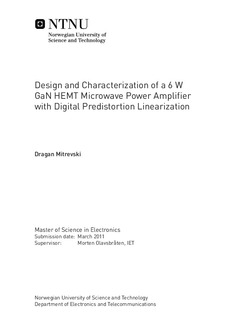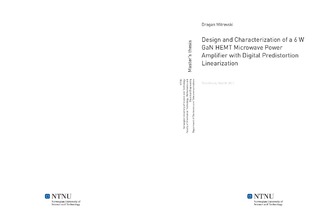| dc.description.abstract | In this thesis, characterization of a 6W GaN HEMT power amplifier for optimal operating conditions through load pull simulations and measurements is investigated.The purpose is to find source and load impedances to achieve for instance maximum efficiency and maximum output power, and investigate whether thesimulated results can be replicated in a measurement setup. Simulations show that when matching for maximum output power, a peak output power of 13W is achieved, while in 1 dB compression, an output powerof 11.40W together with a power added efficiency of nearly 67% is obtained, a remarkable for a 6W device. Matching for maximum efficiency yields a peak power added efficiency of 78% and a peak drain efficiency of 90 %, however, in 1 dB compressionthese levels are 71% and 74 %, respectively. Load pull measurements are performed with a prototype design, however, due to problems with the softwarecontrolling the measurement equipment, the tuning process had to be done manually, which effectively limited the possibility of replicating the simulated results.With manual tuning in coarse steps, two sets for semi optimal operating conditions are found. For the first set of impedances, a peak output power greaterthan 11 W, with a peak power added efficiency of 68% is obtained, while for the second set of impedances, an output power of 7.40W with a peak power addedefficiency of 70% is achieved. The measured performance indicate that the simulated results can be replicated once the measurement setup is working optimally.In addition, the topics of black box characterization and digital predistortion linearization of microwave power amplifiers are investigated. Microwave power amplifiersobtain maximum operational performance when operated close to the saturation point. However, due to the nonlinear behavior of the device when operated inthis region, the output signal will be distorted and cause interference with neighboring channels. Thus, in order to maintain the high operational performanceand avoid adjacent channel interference, it is of great importance to characterize the nonlinear behavior of the device, and compensate for the introduced distortionterms. Digital predistortion linearization is considered to be among the most cost effective linearization schemes as of today, providing flexibility and good performance.The design of a digital predistortion unit amounts to three main steps: deriving a behavioral model of the microwave power amplifier, estimating themodel parameters for the inverse characteristic, and the implementation of the preinverse filter. For behavioral modeling, well known nonlinear models, such asthe Volterra series are investigated, and used with an indirect learning architecture to estimate the parameters of the inverse system.Simulations of the different linearization algorithms show that in an ideal environment, the adjacent channel power ratio can be reduced with up to 25 dB, almostindependent of the model used for the predistorter design. However, when used in a real measurement setup, a maximum reduction in adjacent channel power ratioof only 15 dB is obtained. The relatively large difference in performance is most likely caused by a combination of long term memory effects due to semiconductortrapping phenomena, noise, and modeling errors. | nb_NO |

